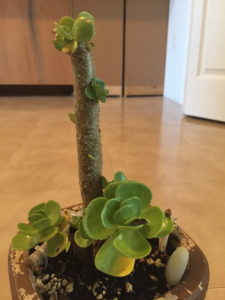Q. I bought this plant from a nursery about a year ago. On and off, I’ve been trying to identify it with various online plant identification sites, but I haven’t had much luck. Could you take a look and tell me what you think? – R.E., Tippecanoe County
A. I believe your plant is one of the succulents belonging to the genus Kalanchoe. Because this genus is so diverse and numerous, it is difficult to know which species you have, but it is likely in the group that is commonly called flapjack plant, paddle plant, or desert cabbage.
Q. I would like to hear about how to get rid of botrytis on grapes. I have been alternating neem and captan this year so far. Will it work? – K.W., Orange County
A. First, you want to be sure you have a correct diagnosis so that an effective control strategy can be selected. There are a number of fungal diseases that infect grapes. Botrytis bunch rot, also known as gray mold, is characterized by gray-brown spore growth of the fungus on the surface of infected fruit, particularly during humid or wet weather. Botrytis is particularly troublesome in tight-clustered grape cultivars. Cultural practices can make a big difference. End-of-season cleanup of old foliage and fruits will reduce overwintering of the fungus. Appropriate pruning during both the dormant and growing season will help open the vines to better air circulation. Wounding by birds, hail, etc., can also promote infection. Fungicides labeled for control of botrytis on grapes include captan, myclobutanil, and mancozeb. Timing is critical since fungicides can only help prevent infection; they cannot cure existing infection. Always read and follow the label directions. If you have frequent troubles with this fungus, you might want to switch to a different, less-susceptible cultivar. Additional information can be found at http://ohioline.osu.edu/factsheet/plpath-fru-03 and http://articles.extension.org/pages/31145/botrytis-bunch-rot-gray-mold-of-grapes.
Q. I own three spruce trees approximately 30 feet tall. They were healthy when planted, but over the years, the lower branches slowly began to die out. Now I have trimmed these branches 6 feet up and the trees don’t look like they used to. Can you tell me what may be wrong and what I can do to save what I have. Even though these are sick, I hate to lose them. – J.F., DeMotte, Ind.
A. There are a number of potential culprits when it comes to spruce. We have several resources to assist.
The Purdue Plant and Pest Diagnostic Laboratory accepts samples (you can start with digital images and follow up with real samples as needed.) There is an $11 charge that covers both the digital images and real samples as a follow-up, if needed. You’ll find more info about this service at http://www.ppdl.purdue.edu.
In the meantime, here are some helpful articles.
Conifer Dieback
https://mdc.itap.purdue.edu/item.asp?Item_Number=ID-477-W
http://msue.anr.msu.edu/news/what_is_spruce_decline_and_what_should_you_do_about_it
Blue Spruce Decline
https://extension.purdue.edu/Porter/pages/article.aspx?intItemID=17881
